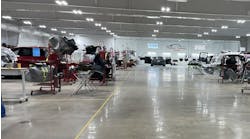Repairing movable glass offers big challenges and rewards
During the past 20 years, vast improvements have occurred in all aspects of automobile construction quality. Cars are safer and more reliable. Today, when you close the door on a newer vehicle you literally are sealed inside the vehicle, in virtual silence. Wind and road noise are almost things of the past.Many newer vehicles utilize technology once reserved for extremely expensive high-line cars. Some European vehicles, for example, automatically maintain a slight gap in the side windows that acts as a release valve during the vehicle entry process. When the door is closed, the window, even if it is rolled completely up, stays slightly down then rolls up automatically. The vehicle does this because the seal is so airtight that the process of closing the door, without relieving some pressure in the cabin, can damage the sunroof mechanism, the quarter glass seal and even the door glass or the door glass mechanism itself (not to mention how difficult it can make just closing the door).
Considering how glass can be damaged during normal operation of the vehicle, think about what can happen in an accident. How many of you have inspected the glass in a vehicle after an airbag deployment? Not the obvious damage, but subtle damage that could easily be overlooked. Have you fixed a vehicle recently then received a complaint from the vehicle owner about wind noise coming from an area opposite of the impact area?
A possible culprit is glass that has been affected by impact forces. You'll want to keep factors like this in mind as you handle glass repairs.
Airbags, pressure and sunroofs
Think about the air pressure build-up that occurs when closing the door on a modern vehicle that is tightly sealed. Imagine the effect of an airbag deploying in this airtight environment. An airbag deploys in milliseconds at speeds of over 200 miles per hour. This force literally can blow the windows out of a well-sealed vehicle.
Sunroofs and moon roofs are especially susceptible to this type of problem. Manufactures have had to re-engineer mountings and slides to address this issue. Understanding this kind of damage can occur during airbag deployment will help you or your staff appraisers more accurately diagnose damage.
Refer to the picture of a typical sunroof/moonroof (see Figure 1). Note the extremely tight fit of the sunroof on this Jaguar S-Type. It is perfectly flush with the roof skin with very even gaps surrounding it. The seal is tight, and the open/close mechanism is quiet and smooth. Even under very high water pressure, like that experienced in an automatic car wash, the sunroof shows no signs of leakage. Obviously, a great deal of engineering goes into these components — the composition and shape of the rubber gasket, the attaching points of the glass panel, and the composition of the glass itself.In the Jaguar S-Type, bolts, hidden under a trim molding (see Figure 2), hold in the sunroof. Most OE sunroofs are similar. The four bolts that secure the glass have some adjustment in them, as do the tracks and slide mechanism. The entire mechanism is engineered to "give" slightly under the stress of an airbag deployment. If the airbag were to deploy in this vehicle, with all the windows closed, the sunroof more than likely would pop upwards slightly, allowing some of the pressure to escape, and then re-seat in the aperture.
Ask your customer if, during the collision, the windows in the vehicle were rolled up completely. If they were, look closely at the sunroof panel. Look at the fit and finish around the sunroof aperture. Even in less expensive vehicles, the fit should be very tight and even. Operate the panel if possible. Check to see if it sticks or makes noise during operation.
Damage identified: How do you fix it?
Repairing sliding moonroofs/sunroofs, especially ones composed of multiple sliding glass panels like those in newer GM vehicles, can be tricky.Performing glass repairs or replacement should begin with formal training like that offered by I-CAR or the vehicle manufacturer. If these options are unavailable, you can get repair help from other sources. For example, you can utilize the tools provided by a high-quality mechanical estimating and repair system. These systems often provide specific repair instructions that can supply a repair roadmap not available elsewhere. These instructions must be followed to the letter to achieve a quality repair.
Though unlikely, if you don't possess an estimating and repair system, you can also turn to a local sublet vendor for help. Most mechanical repair shops and virtually all dealers have an available estimating and repair resource. If you have a good relationship with your vendors, they likely will allow you to access the information you need for a specific repair.Movable side glass
Side glass includes door glass, vent glass and quarter glass. Most side glass is bolted in, though some is glued, and some is clamped. Vent glass can swing out, as with many antique vehicles. It also may roll up and down. Quarter glass usually swings out to open, as it does on a minivan or a hatchback.
Replacing side glass also has become more challenging. Many applications now require specialized tools, adhesives and specialized knowledge on how to access, remove and replace the glass. As with sunroof repair, your shop should invest in any available formal training or turn to technical data available elsewhere before attempting some of the more advanced side glass replacements.The following instructions describe how to replace the front door glass on a 2006 BMW 750 V8.
Step 1: Open the door to a distance of 140 mm for sufficient clearance.
Step 2: Remove the inside door trim panel.
Step 3: Remove the function carrier in the door.
Step 4: Remove the window cavity cover strip.
Step 5: Remove the glass release screws, washers and plastic washers.
Step 6: Turn and lift the door glass out, tilting the rear of the glass upwards.
Step 7: Re-install going from Step 6 to Step 1.
This process may seem simple, and generally is, but on this model a process called normalization may need to be performed after the glass replacement to make certain the glass functions properly. This is particularly true if the vehicle is equipped with "anti-trapping" protection. Normalization records the position and closing forces of the mechanical end stops and stores them in the vehicle's computer. This assures the proper operation of the anti-trapping mechanism, as well as other functions.
A series of operations must be carried out in a specific sequence for the window glass to properly function after work has been performed on the regulator, door module or the power mechanism in general. Without these operations, the door glass may not close or open safely, if at all. Simply removing and re-bolting in a new glass is becoming a less-available option.
Previously, quarter glass was relatively easy to replace and most often bolted or fastened in mechanically. These units have become part of the electronic age and now feature motorized functions that open and close the windows through a switch in the vehicle. These mechanisms also can be damaged by airbag deployment. Make certain your shop checks the operation of this glass whenever an airbag has deployed.
What's in it for me?
Because movable glass replacement in modern vehicles requires specialized knowledge and tools, it can be expensive for shops to perform. However, repairing this type of glass also can be remarkably profitable, especially when you document and bill it correctly. For example, you can justify some additional labor charges due to the complexity of these operations. Note too that your profit on labor, more often than not, is greater than it is on sublet operations. In this age of shrinking profitability, it may be in your shop's best interest to invest in the necessary training and equipment needed to perform these repairs. Automobiles are only going to get more complex. It makes sense to begin getting ready for this inevitability rather than waiting until it's here.




